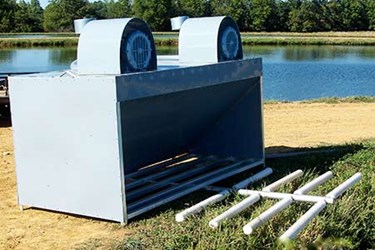LAGOON MASTER™ Sludge Activating Aerator

Over the years many different things have been attempted to assist in degrading the organic matter that builds up in the “sludge” on the bottom of recreational ponds, wastewater lagoons, fish grow-out ponds and small, shallow lakes.
The LAGOON MASTER TM Sludge Activating Aerator by Reliant Water Technologies mimics a secondary clarifier in a lagoon or pond. By using moving water to continuously roll along the bottom of the lagoon, the sludge and all bottom sediments, become activated – eventually, completing the digestion of all of the organic matter in the bottom sediments. This process eventually performs the following:
- Eliminates the organic solids in the sludge completely through microbial digestion.
- Provides enough dissolved oxygen to keep the entire microbial population alive and thriving.
- Oxidizes, through continual vertical mixing, all of the trapped waste gases (nitrogen, ammonia and H2S) in the water column and sludge, thereby cleaning the water.
- Eliminates all odors in the body of water.
- Eliminates stratification and seasonal turnover throughout the entire body of water.
- Reduces the sludge buildup to the point that pond/lagoon dredging is set back indefinitely.
